Climb Mount Tai to enjoy the famous lake and see the grassland, and a 12-day leisure train and plane tour in Inner Mongolia, Shandong Province

D1. Take the subway for 4 yuan from home with his wife to Xi'an Railway Station. The renovated Xi'an Railway Station still has the ancient charm and new sound, and the style of the imperial city is majestic. Along the way, I passed through Shaanxi, Henan, Jiangsu, Hebei, and Shandong, and experienced the customs of various places outside the window. I ate 18 yuan instant noodles and egg side dishes on the bus to solve my stomach problem. After 13 hours, I arrived at Taishan Railway Station in the middle of the night. The hotel is 500 meters in front of the train station. On a few minutes 'walk, we ate a bowl of beef ramen for 12 yuan and checked in and rested at the hotel next door.
Mount Tai, the crown of the Five Mountains, is located in Taishan District, Tai 'an City. Taishan District covers an area of nearly 300 square kilometers and is a small city with a population of about 800,000. Mount Tai Scenic Area has undulating mountains, mountains and valleys. The highest altitude (Mount Tai Yuhuangding) is 1,532.7 meters, which is the highest peak in Shandong Province. The surrounding areas are all low mountains, hills and alluvial plains, and the terrain is relatively flat, so I feel that I will climb to the top and see all the small mountains.


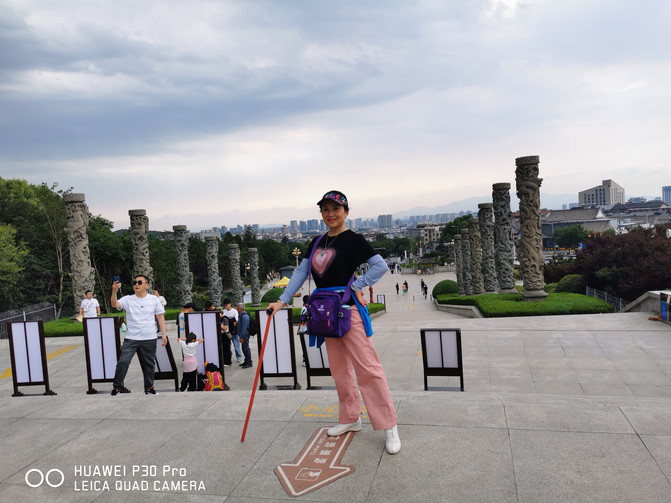

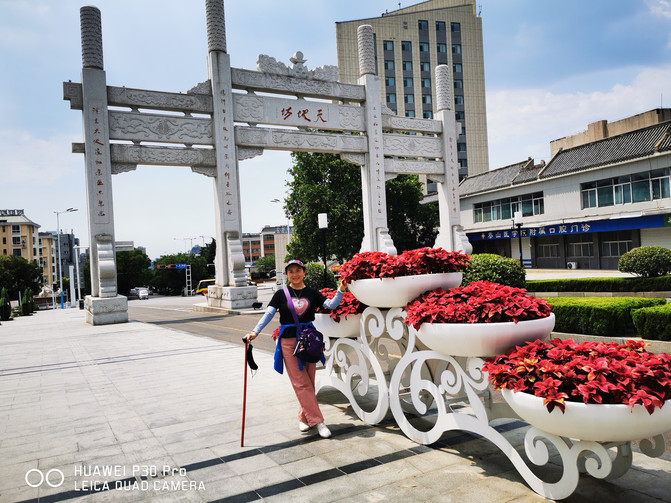
D2. After breakfast, I walked straight along the road to Mount Tai and reached the entrance of Tianwai Village Scenic Area at the foot of Mount Tai in 40 minutes. I spent 5 yuan to buy a walking stick and prepared to take the cable car up the mountain. However, we were told that the cable car here was out of maintenance and we could detour to the Taohuayu Cableway up the mountain, so we decided to go again the next day. Then on the way back to the hotel, I enjoyed the park scenery and street views all the way, tasted local snacks and drinks at a small hotel for 79 yuan, and then returned to the hotel for a lunch break. When I renewed the hotel, I was hospitable to Shandong and had frequent surprises: the hotel waiter saw that the price I booked was a little higher, so he took the initiative to help me operate it on my mobile phone, saving dozens of yuan. In the afternoon, I went to the supermarket to buy fruits and food ready to go up the mountain for 152 yuan. Hospitality in Shandong, I met another surprise: my glasses were broken, so I went to the optical shop to get a part. After it was repaired, it was actually free. I even warmly greeted him and sat down with tea. Dinner was eaten at a nearby restaurant for 93 yuan.


D3. After breakfast, take a taxi for 28 yuan to reach the cable car entrance of Taohuayu Scenic Area. Tickets for the scenic area and one-way shuttle bus are 35 yuan (half price for the elderly), and one-way cableway is 150 yuan (100 yuan for the elderly). On the way up the cable car, you can enjoy the beautiful scenery in the sky and easily climb the mountain to Tianjie. Walking on the seemingly ordinary commercial street on Tianjie has a unique taste, showing the hardships of mountain pickers. After walking through Tianjie and climbing the steps, we soon reached the Nantian Gate. Not far from the top of the mountain is the Jade Huangding where everyone gathered. From here, you can overlook the earth under your feet and have a panoramic view of the green and undulating mountains, set off by blue sky and white clouds. It is very spectacular; but it feels like "you will be at the top of the mountain and see all the small mountains". It can really be said to "gallop through Qin, Yu, Su and Qilu, and harmonise with heaven, earth and people with God's blessings." Mount Tai has been worshipped as an immortal emperor, but today the five mountains are different."
After going down the mountain, take a bus back to the hotel for 4 yuan, and taste local specialty dumplings at a nearby dumpling restaurant for 86 yuan."It's not as comfortable as upside down, and it's not as delicious as dumplings."












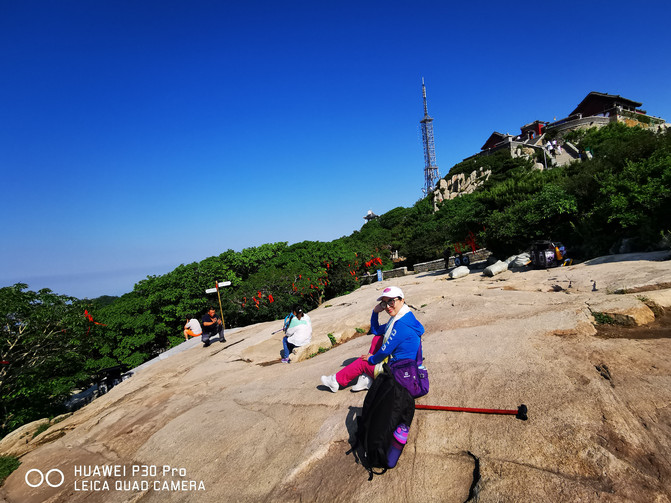



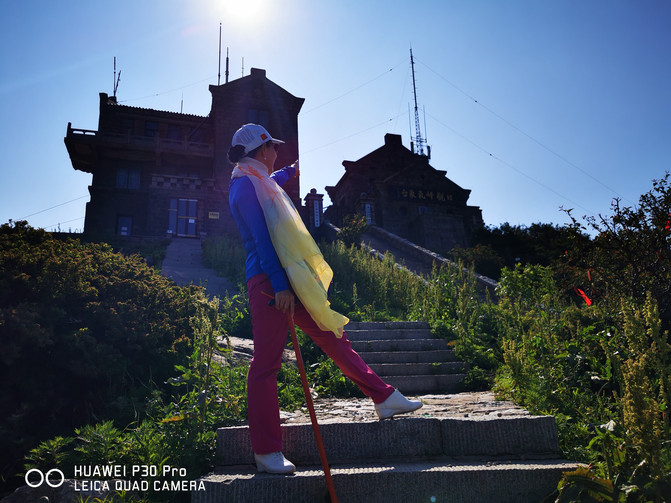









D4. After breakfast, take the train from Mount Tai to Jinan booked for 12 yuan. After about an hour's drive, you arrive at Jinan Railway Station. The hotel booked for 150 yuan is 500 meters in front of the train station and a few minutes 'walk. Jinan City, also known as Quancheng, is the capital of Shandong Province and a sub-provincial megacity, with a total area of about 10000 square kilometers and a population of nearly 10 million.
After resting and tidying up, I took a bus for 2 yuan to visit the "Grand View Garden" in Jinan Old Street. The architectural decoration here is quite ancient and is basically a commercial district. I tasted Jinan's traditional cuisine here for 45 yuan at noon.







After lunch break, ride a shared bicycle, take a walk around, and feel the Qilu flavor of Jinan's old streets and new roads with profound cultural heritage. Quancheng Park located in the suburbs is a scenic and botanical garden with a superior geographical location and beautiful natural environment. It is a good place for citizens to relax and play. It is also the largest urban park in China. Wulongtan Park is located opposite the north gate of Baotu Spring and is one yuan of the Baotu Spring Group. It has beautiful scenery and a long history. It has stories and objects. It is a good place to enjoy the garden, see flowers and play with water.
Daming Lake is the largest urban water park in Jinan. We specially changed the hotel and lived right opposite its north gate. It was very convenient to go there at night. They were all free citizen parks.
D5. After breakfast, take a taxi for 12 yuan to visit Baotu Spring, and the ticket is 40 yuan (half price for those over 60 years old). Baotu Spring is known as the "No. 1 Spring in the World" and is located in the center of Jinan City. It is a national 5A scenic spot and a famous cultural park with springs and cultural landscapes as the main focus. It is the symbol and symbol of the Spring City of Jinan, so Jinan is also called Spring City. There is also the former residence of Li Qingzhao, a famous female poet in the Song Dynasty. It is small and exquisite and has elegant scenery. The wax figures in the exhibition hall show the life scenes of that year. There are large ancient buildings and many Yufang stone carvings, all of which are poems written by celebrities from past dynasties. In the park, pavilions, stone tables and stone benches can be used for tourists to rest and enjoy the spring. At that time, Emperor Kangxi and Emperor Qianlong used to sit quietly here by the water and sip tea and enjoy the spring. The springs and ponds in the park are sparkling, the golden walls of pavilions and pavilions are brilliant, and the environment is quiet and the scenery is pleasant. It looks like a wonderful fairyland on earth that makes people forget to leave.








Play until noon, take a taxi for 10 yuan to visit the ancient city of Jinan in Baihuatan. Baihuazhou Historical and Cultural District is also located in the central area of Jinan's old city. It is the focus core area of natural, humanistic, traditional, historical and cultural heritage in Jinan City. It is also the core commercial district with "one city with mountains and half a city and lake". The traditional streets and alleys in the district are well preserved and rich in traditional architectural heritage. People who come to visit Jinan will say something that has always been very popular: "Your Majesty, do you still remember the Xia Yuhe on the shores of Daming Lake?" In fact, Xia Yuhe's story is not just compiled in "Princess Huanzhu", but a folk legend. In Baihuazhou, there was a creek called "Yuhe Creek" early on, there was an alley called "Yuhe Lane", and there was a yard called "Yuhe Ju", which commemorates the love story of Xia Yuhe and Qianlong.




A pot of tea for an emperor, and the people have no bounds to think about. Visiting Daming Lake has a feeling. (Visit the shores of Daming Lake, look for summer rain and lotus traces, eat delicacies from Furong Street, and travel leisurely in Jinan.)
Legend has it that Emperor Qianlong visited his country, accompanied by ministers Liu Luoguo and Liu Yong, who came to Daming Lake to see lotus flowers. Walking through the streets and alleys on the shores of Daming Lake, you will come to Qushuiting Street. The arched bridge creek, the gurgling spring water, and the green water and grass are green, giving you a unique scenery. There were also people playing the piano. Qianlong followed the sound and looked for it. There was a beautiful girl playing "High Mountains and Flowing Water" on the shore. Qianlong went over to chat with her. This girl was Xia Yuhe.
Qianlong was an emperor after all, with a good figure, handsome, talented, and powerful aura. Xia Yuhe was also the daughter of a wealthy family. She knew everything about piano, chess, calligraphy and painting, and was beautiful. The two fell into the whirlpool of love. After that, Qianlong spent every day with Xia Yuhe watching flowers and singing willows, chatting about love, playing chess, calligraphy and painting, and poetry, and rafting on Daming Lake inseparable. His love lasted forever.
Liu Luoguo and Liu Yong advised the emperor,"Take some time off while you are busy and go play chess; take some peace in the chaos and come after making tea." It was time to return to the capital to manage major national affairs. Although Qianlong was reluctant, he still told Xia Yuhe that he was leaving.
Xia Yuhe was very painful, but she was very understanding and left a poem for Qianlong: "You should be like a rock, and my concubine should be like cattail grass." The cattail grass is as tough as silk, and the rock does not shift." Qianlong sighed and told Xia Yuhe that after I return to Beijing, I will send someone to pick you up.
While Xia Yuhe was waiting for Qianlong, the Xia family was very distressed by the son of the wealthy Yuan Zhang of Jinan Prefecture who wanted to marry Xia Yuhe. After Liu Luoguo and Liu Yong found out, he made a plaque "Zhilan Di" and had it hang at the door of Xia's house. Once this plaque is hung, it will suppress the people of Jinan. Liu Yong, an important minister beside the emperor, wrote a plaque for the Xia family. The Xia family is not ordinary. Who would dare to make a mistake? Now the courtyard of "Zhilan Di" has been changed to "Baihuazhou Theater".
Qianlong turned around, and Xia Yu and the willows and green grass turned yellow. After more than ten years of thinking about it, he finally died of illness. Some people say that Qianlong was heartless, but not all of them were true. Folk legends have jokes, and Jinan history books have connotations.
Lunch was served at a small restaurant in the ancient city for 18 yuan per person. After that, I took a taxi back to the hotel for 10 yuan to rest.
D6. After breakfast, step out of the hotel and you will see the north gate of Daming Lake Scenic Area across the road. You will see the scenery when you walk. The scenic area is very large, with a lake surface of 58 hectares. It is a natural lake and is open to the national 5A-level tourist attraction for free.










The buildings around Daming Lake have been famous all over the world. The environment of "one pavilion, three gardens, three floors, four temples, six islands, seven bridges, and ten pavilions" is elegant and atmospheric. Leisure and sightseeing reproduce the spring city characteristics of "lotus flowers on all sides and willows on all sides, one city, mountains and half a city." Daming Lake Park has gradually formed a multi-functional, modern and classical tourist area integrating sightseeing, shopping and entertainment, cultural appreciation, and catering services.
Cross the small bridge through the tree-lined trees, walk from the north gate to the south gate, cross the road to the Baihuazhou Historical and Cultural District in the ancient city of Jinan. Go around again and find a small restaurant for lunch. It is delicious, the price is reasonable, and the food is comfortable. 59 yuan per capita.
After lunch, I took a taxi back to the hotel for 10 yuan to rest. Since it was the evening train, I renewed the rental for an hourly room for 3 hours and 60 yuan. For dinner, I ate authentic Jinan steamed buns at the steamed bun shop downstairs. I drank all kinds of porridge for 3 yuan, and the average person was 12 yuan. It was really good. After that, I got on the bus at the nearby Daming Lake Railway Station and headed for Hohhot, the capital of Inner Mongolia.


D7. The two-person sleeper bought from Jinan to Hohhot for 260 yuan was not in the same carriage, so I tried to ask a young man next to me if he could change it? I didn't want to be hospitable to Shandong, but there were many surprises: a young man readily agreed to exchange, and the lower berth was replaced by my middle berth, and he didn't charge the difference. I am grateful and deeply moved! After a 15-hour train trip, we arrived in Hohhot City, the capital of Inner Mongolia. The hotel I booked for 150 yuan/day/room turns right about 100 meters when you exit the train station. The lobby is spacious and bright, and there is also a travel agency, which is very convenient. The room was clean and tidy, and the facilities were very comfortable.
Hohhot is abbreviated as Hohhot, which means "blue city" in the Mongolian sense. It was formerly known as Guisui and alias Qingcheng. It is the dairy capital of China. The capital of the Inner Mongolia Autonomous Region has a long history and splendid culture. It is a national historical and cultural city and one of the birthplaces of Chinese civilization. It is the birthplace of Hufu riding and archery, the destination of Zhaojun's departure from the fortress, the Longxing land of Xianbei Tuoba, the place where merchants in Mongolia exchange trade, and the frontier of the intersection, collision and integration of nomadic civilization and agricultural civilization. It is now an important bridge connecting the Yellow River Economic Belt, the Eurasian Continental Bridge, and the Bohai Rim Economic Region. It is also an important border open center city for China to open to Mongolia and Russia. The total area is nearly 20000 square kilometers and the population is about 3.5 million.
I checked in and packed up, went downstairs and had lunch for 44 yuan. The travel agency in the hotel lobby signed up for a two-day tour to the grassland the next day for 300 yuan. Then rest and prepare for tomorrow's trip.


D8. After breakfast, we checked out and stored our luggage in the travel agency. The travel agency took us to the bus gathering point in a small car. It took about two hours to reach the Xilamuren Grassland. The tour guide joked that if you couldn't remember the name of the grassland, you would remember the homophonic pronunciation of "a sparse grassland", haha. The scenery outside the window was pleasant along the way, and the speed was very fast. There were not many outsiders or cars, which fulfilled the tour guide's words. In fact, Xilamuren means "Yellow River" in the Mongolian word.
After getting off the bus, I was warmly received by girls dressed in red Mongolian national costumes and presented Hada to drink welcome wine. Then they arranged to choose knight hats and travel on horseback and carriage to the grassland. I learned a little common sense of riding from the knight I led. When I rode a horse for the first time, I easily didn't pull the reins. I let the horses gather in piles and parallel. I trusted the horses to be free. The grassland was wide and flat, and I walked very light. Arriving at Aobao Mountain to enjoy the grassland scenery. The endless scenery makes people mesmerizing.

More than an hour later, I returned to the meeting place and set off for Honggar Daobo. It was built during the period of Genghis Khan's brother Hasar. It has a history of more than 400 years and is an important core scenic spot. It restores the life scenes of the Mongolian people during the 13th century, highlighting the Mongolian people's original religious beliefs and the military cities of the Mongolian army during the 13th century. After getting off the bus, we climbed up the steps on the wooden plank road and reached the high Daaobao platform about 200 meters. It is the "soul of the grassland" in the hearts of Mongolian herdsmen. The Mongolian people built a pile of stones to commemorate the heroes who sacrificed their lives heroically in the war. The relics of heroes are generally stored in Aobao. They are altars for people to worship heaven and pray for rain, and are also road signs in the grassland. Through some sacrificial activities here, we pray for blessings and bless the prosperity of both people and livestock. We also made three rounds around Aobao from left to right in accordance with local customs to pray for a smooth journey, health and happiness.








After visiting Daaobao, we entered the even more shocking equestrian performance square. The stands of more than 2000 people were packed. A large-scale live-action equestrian drama "Legend of Monan" performed by more than 100 grassland knights is about to be staged. According to the tour guide, it has performed for many central leaders and is very beautiful! From the magnificent music and large-scale scenes, it reproduces the national atmosphere of the Mongolian people who love peace and bravely fight against strong enemies. The scene of the warriors returning triumphantly and celebrating enthusiastically. This 40-minute large-scale live-action equestrian drama "The Legend of Monan" reproduces the heroic picture of the Mongolian nation growing and growing on the grasslands during the Genghis Khan era, galloping on the battlefield, and making contributions! Allow tourists to have a deeper and comprehensive understanding of the political and cultural life evolution of Mongolian tribes in shock, so as to truly understand the origin and inheritance of the Mongolian people. With their superb individual and team skills, individual and collective martial character interpretation, and a strong team performance lineup, the equestrian actors reproduce the picture of the Mongolian nation growing and growing on the grassland and galloping on the battlefield 800 years ago. The scene is shocking and the plot is moving, making people forget to leave.
After watching the performance, I drove to the large yurts where I lived at night. Although it was a cement building, the appearance had a traditional Mongolian charm, the interior looked like a modern hotel, and the facilities were quite complete. After check-in, the tour guide arranged to attend the "Horse Fraud Banquet" in the evening, plus all the activities throughout the day. The per capita fee is 980 yuan, which may seem quite expensive but worth it.



The horse fraud banquet is a unique Mongolian celebration banquet for whole cow mats or whole sheep mats. Fraud horses, Mongolian language, refers to whole animals with their hair removed. It means that after cattle and sheep are slaughtered, the hair is removed with hot water, the internal organs are removed, the whole cattle and sheep are roasted or boiled, and then eaten. The horse fraud banquet began in the Yuan Dynasty and developed into a luxurious court banquet, entertaining relatives, ministers, close attendants and other personnel. According to the etiquette of the horse fraud banquet in the Mongolian court of the Yuan Dynasty, all attendees wore the costumes of Mongolian princes and aristocrats. This was a celebration that integrated banquets, singing and dancing, games, and competitions. It was the most luxurious and grand banquet at that time. We had the honor to participate in the banquet that night, eating and drinking while watching. The Mongolian cast members once again demonstrated the enthusiastic and uninhibited Mongolian culture and inheritance with vivid language, singing and dancing. Many tourists can't help but participate in it and have fun and entertainment. Being able to participate in this grassland tourism personally makes us feast our eyes and taste and feel very happy.
After the dinner, the bonfire party that should have been scheduled was cancelled due to the rain and cold weather that night, so it was slightly regrettable.
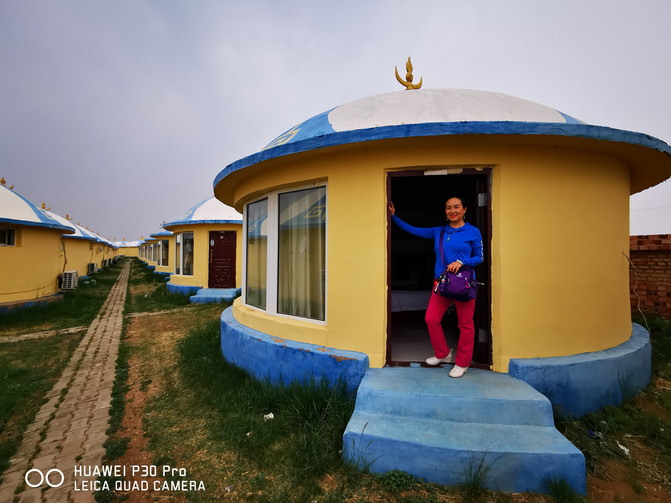

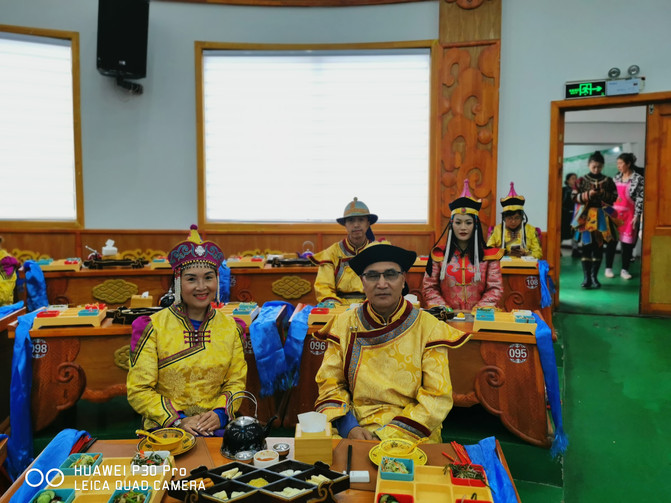


D9. After breakfast, take the bus back to the original hotel. The travel agency owner helped us rebook this hotel, which was dozens of yuan cheaper than our own booking. Thank you very much.
After tidying, resting, and lunch, it is also very pleasant to scan the code and share a bicycle to walk around the city. The Hohhot Museum, the Fu 'anmen Site of Suiyuan City in the Qing Dynasty, the Great Hall of the People in Inner Mongolia, Times Square, the railway station, and the streets and roadsides have all become the beautiful scenery in my lens.
Hohhot Museum (Baima Hall) was built in 1957. It is one of the historical landmarks in Hohhot City. It is located in the central area of the city and is an autonomous region-level cultural relic protection unit. Because of the shape of a white horse galloping in the sky at the top, it is called the "Big White Horse Museum". It covers an area of 12000 square meters, a construction area of 5400 square meters, and an exhibition area of 3650 square meters. It is open to the public free of charge.
Across the road is the Fu 'anmen ruins of Suiyuan City in the Qing Dynasty. It is now a small square and park. The ruins and buildings are not seen, and the modern buildings have a unique style.
The Great Hall of the People in Inner Mongolia not far away is magnificent but not open to the public. Take a photo from a distance. Times Square is still a big shopping mall, so I didn't enter it. However, it is magnificent from a distance, with a distinctive golden appearance. The train station seems to be the one from many years ago, with many buildings and service facilities around it. In the eyes of a foreigner like me, the scenery photographed on the street has a unique style.
Dinner will be served at the small restaurant opposite the hotel for 23 yuan. I will go back to the hotel to rest and prepare for tomorrow's tour.
D10. After breakfast, take Metro Line 2 for 3 yuan to Exit C of Inner Mongolia University South Campus, and pay 15 yuan to Zhaojun Museum. Zhaojun Museum, known as Zhaojun Tomb, also known as the "Green Tomb", is the cemetery of Wang Zhaojun, the Ming Consort of the Han Dynasty, recorded in historical records and folklore. Located on the south bank of the Dahei River, nine kilometers south of Hohhot City, it was built during the Western Han Dynasty BC and built. The tomb is shaped like a covered bucket, 33 meters high and a bottom area of about 13000 square meters. It has a long history of more than 2000 years and is one of the largest Han tombs in China. It is now a national 4A-level tourist attraction and a key cultural relic protection unit in the Inner Mongolia Autonomous Region, with an area of nearly 700 acres.

After entering the museum, a main road leads directly to the tomb of Zhaojun in the back mountain. At the premiere, you will see the white jade statue of Zhaojun. It is dignified and beautiful, with a long dress fluttering like a fairy descending from the world. Next is a colorful statue of Zhaojun and Chanyu on horseback. Chanyu stared at Zhaojun affectionately, and Zhaojun responded beautifully. On the left side of the road is the Ancient Chinese Harmony Culture Museum, and on the right side is the TV Image Exhibition Hall. On the hillside below the tomb of Zhaojun in the back mountain, there are steles of emperors and executives and celebrities from various dynasties, which fully reflects everyone's respect and love for Wang Zhaojun, the goddess of Luoyan, one of the four ancient beauties.








Wang Zhaojun at that time was named Qiang, the word Zhaojun, and the nickname Haoyue. He was born in Zigui, Nannan County of the Western Han Dynasty (now Xingshan County, Yichang City, Hubei Province). In order to unite the country and the nation, at the age of 20, he was summoned by the emperor to marry Huhanye, the leader of the Southern Xiongnu, a vassal state of the Han Dynasty, leaving behind the popular story of "Zhaojun leaving the fortress". Today's Zhaojun Tomb is like a bright pearl on the northern grassland and has become a world-famous tourist attraction. There are not only historical cultural relics and historic sites, antique Zhaojun's hometown, garden pavilions, water stream ponds, but also the natural taste of birds singing and flowers and the unique cultural landscape. Its poetic and picturesque meaning makes people linger. About two hours after the visit, I paid 20 yuan to return to the subway station, and took the subway for 3 yuan to return to the hotel to rest. Lunch was still served at the small restaurant opposite the hotel for 48 yuan.
In the afternoon, ride a shared bicycle and come to Qingcheng Park for about 20 minutes. Qingcheng Park is located in the center of Hohhot and is a comprehensive cultural and leisure park in the city. With a total area of 44.82 hectares and a green coverage rate of 80.8%, it is the natural "green lung" in the Main City of Hohhot City. In the park, towering willows and flowers are blooming, hundreds of birds are singing, and the lake water is wide. Known as the natural "green lung" of the Urban area, there is a pavilion island in the center of the lake in the park. The lake water is clear and sparkling, and white and colorful swans wander and play freely. Tourists sing, dance, walk and exercise here, which is very comfortable. Play until the starry night, ride a shared motorcycle for 10 minutes and return to the hotel to rest.
D11. After breakfast, ride a shared bicycle for more than ten minutes to reach the General Fushu Ruins Museum. The General Yamen Office is located in the central area of Hohhot. It was built in the fourth year of Qianlong (1739). It is one of Hohhot's important monuments and a key cultural relic protection unit in Inner Mongolia. At that time, Suiyuan City commanded the eight banners of Manchu, Mongolian and Han garrisons and was the highest authority in charge of the military and political affairs in the northwest. General Suiyuan was a first-class official of the Qing Dynasty and was stationed here as a general of the country. After liberation, the Yamen Office was the office of the Suiyuan Provincial People's Government and the Inner Mongolia People's Government. The General Yamen Office covers an area of 26,400 square meters. After many repairs and renovations, it is open to the public free of charge. It has become a multi-purpose museum integrating ancient architecture display and regional history publicity, recreating the grand scene of the "First Mansion of Moran".
Visit and browse for two hours, continue riding a shared bicycle back to the hotel.
After lunch and rest, ride a shared bicycle for ten minutes to visit Princess Mansion Park. This is a regional cultural park, where you can feel the peach red willows green, winding paths leading to the secluded scenery, and elegant pine style.

There is also a monument to the soldiers killed in the War of Resistance against Japan, which is awe-inspiring. 74 years ago, the officers and soldiers of the 59th Army fought heroically with the enemy for 15 hours. 367 officers and soldiers died heroically and finally won the battle. In order to commemorate the fallen soldiers, the remains of 203 soldiers and soldiers who were found to have died were buried here to commemorate and commemorate the future.
Return to the hotel in an hour to prepare for the next day.
D12. After breakfast, take a taxi for 10 yuan to Dazhao Wuliang Temple. The Chinese name is "Wuliang Temple", and the Mongolian name "Yikzhao" means "big temple"; it is located in the center of Hohhot. It was founded by Alatan Khan, the leader of the Tumut tribe of Mongolia in the Ming Dynasty, in the seventh year of Wanli (1579) of the Ming Dynasty. It was the earliest Lamaist temple built in Hohhot and belonged to the Gelug Sect (Yellow Religion). Legend has it that it is the emperor's family temple. Emperor Kangxi once lived here for a few days, so it is also a rare temple in Inner Mongolia that does not have a living Buddha. Dazhao Temple covers an area of more than 30,000 square meters, of which a construction area of more than 8,000 square meters. There is a silver Buddha, also known as the "Silver Buddha Temple", in the temple. The silver Buddha statue of Sakyamuni enshrined in the Daxiong Hall is more than 400 years old and is one of the largest surviving silver Buddhas in China. The Buddha statue sits in a sitting position, is 3 meters high, and is cast of pure silver. Dazhao is not only a Buddhist holy place, but also a well-known tourist resort at home and abroad. The glorious Zhaomiao architecture, precious cultural relics and art, as well as the mysterious Qiamu dance and Buddhist music, constitute Dazhao's unique "Zhaomiao culture".


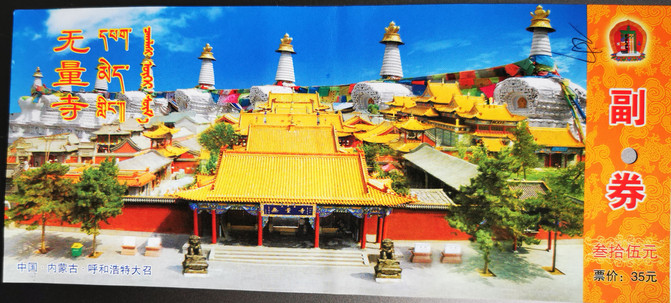



However, the climate has changed greatly in Hohhot, which is a place where the temple is still shining brightly and the heat is so hot that I am sweating. When I walked to the Daxiong Hall, it suddenly rained heavily and lasted for about an hour. It gave us an opportunity to stay and learn more in the temple.
After the rain stopped, stroll to the west side of Dazhao Temple, where there is a well-preserved Ming and Qing streets with blue bricks and gray tiles and flying eaves and arches. It has been valued by the entertainment industry and has become a location for filming costume films. It is famous for its ancient antiques, calligraphy and paintings, jade articles, Mongolian leather paintings, copper utensils and other handicrafts. There is also a food street, which brings together various specialties from all over the country, especially local specialties. The small shop has unique decoration, flexible and thoughtful management, and delicious aroma. It has also become a popular place for Internet celebrities to check in. After visiting the temple, I came to the "Old Street on the Wall" to see the style of ancient times and the delicious food that came here. Although it is a tourist attraction, I tasted a variety of snacks for 110 yuan. The price is not surprisingly high, and the value is quite high.
It takes about 3 hours to visit attractions and taste delicious food. Take a taxi back to the hotel for 10 yuan to rest.



D13. Because I was tired from playing for a few days, I slept until I woke up naturally. After lunch for 9 yuan, I packed up and checked out. Take the subway for 5 yuan to the airport, eat a cold drink and snack at the airport for 8 yuan, and fly back to Xi'an for 382 yuan.
I was quite shocked and cordial to see the 100-meter scroll "Great Qinling Mountains: China's Backbone" at Airport T3. The scroll is 100 meters long and 2 meters high, showing the scenery of the Qinling Mountains from Tongguan in the east to Taibai in the west, and showing the rich and profound historical accumulation and weather of the Qinling Mountains. The painting was created collectively by more than 20 outstanding young painters. Famous painters Cui Zhenkuan, Zhang Zhenxue and Zhao Zhenchuan served as art consultants. Famous writer Jia Pingwa, vice chairman of the Chinese Writers Association and chairman of the Provincial Writers Association, wrote the inscription and postscript. Lei Zhenmin, vice chairman of the Shaanxi Province Federation of Literary and Art Circles and honorary chairman of the Provincial Writers Association, was named. The paintings are comely, solid, majestic and free. They use poetic ink and images to sing praises of the great Father Mountain and praise and bless the motherland. I am very happy to have the opportunity to meet you in the first place, so I took a photo and enjoyed it.
Take the airport bus back to the city for 25 yuan, and take a taxi back home for 20 yuan, ending this precious trip to see the mountains, admire the water and grassland. The per capita cost is about 2500 yuan, which is very worth it!
Previous Article:2019 trip to Xi'an
Next Article:Visiting relatives in the ancient capital of the thirteen dynasties, I regret leaving next time!!!
